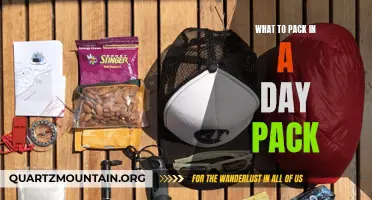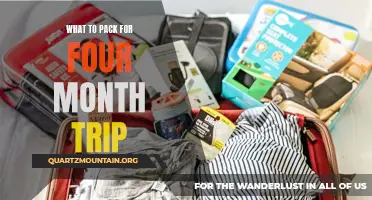
Embarking on the Salkantay Trek is undoubtedly an adventure of a lifetime, where you'll witness breathtaking landscapes, conquer challenging terrains, and immerse yourself in the rich culture of the Andean region. However, before you can begin this incredible journey, one essential task is to create a thorough packing list. From sturdy hiking boots to warm layers and waterproof gear, this article will guide you on the essential items you need to include in your Salkantay Trek packing list, ensuring a comfortable and memorable experience in this awe-inspiring destination.
What You'll Learn
- What essential items should I pack for the Salkantay Trek?
- How many changes of clothing should I bring for the Salkantay Trek?
- Do I need to bring my own sleeping bag for the Salkantay Trek?
- What type of footwear is best for the Salkantay Trek?
- Are there any specific items or gear that are recommended for the Salkantay Trek?

What essential items should I pack for the Salkantay Trek?

The Salkantay Trek in Peru is a popular and challenging adventure that takes you through breathtaking landscapes and brings you face-to-face with the majestic Salkantay mountain. As with any trek, it is important to pack the right essentials to ensure a successful and comfortable journey. Here are some essential items that you should pack for the Salkantay Trek:
- Reliable Hiking Boots: Hiking boots are perhaps the most important item on this list. The Salkantay Trek involves traversing various terrains, including rocky paths, muddy trails, and steep ascents and descents. A sturdy pair of hiking boots with good ankle support and grip will protect your feet and prevent injuries.
- Weather-Appropriate Clothing: The weather in the Andes can be unpredictable, so it is crucial to pack clothing suitable for a range of conditions. Layering is key, as it allows you to adjust to changing temperatures throughout the day. A breathable base layer, insulating mid-layer, and waterproof outer layer will keep you comfortable and protected from the elements.
- Sleeping Bag: The Salkantay Trek involves camping in the mountains, so a good quality sleeping bag is essential. Nighttime temperatures can drop below freezing, so opt for a bag with a comfort rating that suits your needs. Remember that a good night's sleep is crucial for maintaining energy levels during the trek.
- Backpack: Your backpack should be spacious enough to hold all your essentials without being too heavy or cumbersome. Look for a backpack with a capacity of around 40-50 liters, with adjustable straps and padding for comfort. It should also be waterproof or come with a rain cover to keep your belongings dry.
- Water Purification System: Clean drinking water is a must on any trek, and the Salkantay Trek is no exception. While there are water sources along the route, it is important to treat the water before consuming it. A water purification system such as water purification tablets or a filter will ensure that you have safe and potable water throughout your journey.
- Snacks and Energy Food: The Salkantay Trek is physically demanding, and you will burn a lot of calories during each day's hike. Pack plenty of lightweight, high-energy snacks such as nuts, dried fruits, energy bars, and chocolate to keep you fueled and energized. Don't forget to pack enough food for the duration of the trek.
- First Aid Kit: Accidents can happen during any trek, so it is essential to carry a well-equipped first aid kit. Include items such as adhesive bandages, wound dressings, antiseptic ointments, painkillers, blister treatments, and any personal medications you may require. It is also advisable to learn basic first aid skills before embarking on the trek.
- Trekking Poles: Trekking poles can greatly help reduce the strain on your legs and joints, especially during steep ascents and descents. They provide stability and support, making the trek easier and reducing the risk of injuries. Look for lightweight, adjustable poles that can be easily packed when not in use.
- Headlamp: A headlamp is an essential item for the Salkantay Trek, especially for early morning starts or late-night trips to the bathroom. Opt for a lightweight and compact headlamp with a strong beam and long battery life. Don't forget to bring extra batteries or a portable charger.
- Cash and Identification: It is important to carry some cash in small denominations for emergencies and to pay for any additional services or purchases along the way. Also, carry a copy of your passport and any necessary permits or documents required for the trek.
In conclusion, packing the right essentials is crucial for a successful and enjoyable Salkantay Trek. Be sure to invest in good quality gear, prioritize comfort and safety, and always be prepared for changing weather conditions. Remember, it's better to be over-prepared than underprepared in the mountains. Happy trekking!
Essential Items to Pack for Your First Ski Trip
You may want to see also

How many changes of clothing should I bring for the Salkantay Trek?

When embarking on the Salkantay Trek, it is crucial to pack the right amount of clothing to ensure comfort and practicality throughout the journey. The Salkantay Trek is a challenging and adventurous multi-day hike that takes you through diverse terrains, including mountains, jungles, and remote villages. Therefore, it is essential to bring an appropriate number of clothing changes to accommodate the varying weather conditions, maintain hygiene, and stay comfortable. Here is a step-by-step guide to help you determine the right number of clothing changes to pack for your Salkantay Trek adventure.
- Understand the climate: The first step is to familiarize yourself with the weather conditions and climate patterns in the Salkantay region. This will give you an idea of the possible temperature ranges, precipitation levels, and overall climate during your trek. Typically, the region experiences a wide range of temperatures, ranging from hot and humid in the jungle areas to cold and windy in the higher-altitude mountain passages.
- Plan for layers: Layering is the key to staying comfortable during your Salkantay Trek. Instead of packing bulkier clothing items, opt for multiple lightweight layers that can be added or removed based on the temperature and your level of activity. This approach allows for better temperature regulation and prevents sweating or chilling during the trek.
- Consider the duration of your trek: The number of clothing changes required will depend on the duration of your Salkantay Trek. If you are planning a shorter trek of 3-4 days, you can pack fewer changes of clothing. However, for longer treks of 5-7 days or more, it is advisable to pack additional clothing items to maintain proper hygiene and freshness.
- Pack essentials: Regardless of the duration of your trek, there are certain clothing items that should always be included in your packing list. These essentials include:
- Moisture-wicking base layers: Pack enough lightweight, moisture-wicking t-shirts or tops to keep you dry and comfortable during the trek. Opt for materials such as merino wool or synthetic blends that are known for their moisture-wicking properties.
- Insulating layers: Depending on the expected temperature range, include a fleece jacket or a down/synthetic insulated jacket to keep you warm during colder nights or higher altitudes.
- Waterproof and windproof outer layer: Invest in a good-quality waterproof and windproof jacket or raincoat to protect yourself from unexpected rain showers or gusty winds during the trek.
- Trekking pants: Pack 2-3 pairs of quick-drying and lightweight trekking pants that offer mobility and comfort during the hike.
- Undergarments and socks: Bring enough sets of moisture-wicking underwear and several pairs of socks to keep your feet dry and prevent blisters.
- Hygiene considerations: While packing clothing changes, remember to also consider hygiene factors. Depending on your personal preferences and the availability of laundry facilities, pack enough changes of undergarments and socks to maintain cleanliness and reduce the risk of odors or infections.
- Consider laundry options: Some trekking companies or accommodations along the Salkantay Trek may offer laundry facilities or services. If you plan to avail these services, you can minimize the number of clothing changes you need to pack and save some space in your backpack.
- Test your clothing choices: Before setting off on your Salkantay Trek, it is advisable to test your clothing choices and layering system. Go on a few day hikes or walks in similar weather conditions to ensure that your clothing is comfortable, practical, and suitable for the trek. This will help you make any necessary adjustments or additions to your clothing choices before the actual trek.
Remember, packing the right number of clothing changes for your Salkantay Trek is crucial for your overall comfort and enjoyment of the journey. By considering the climate, duration of the trek, and hygiene factors, you can pack the right amount of clothing to stay comfortable and prepared for any weather conditions you may encounter along the way.
Essential Items to Pack for a Trip to Cuenca, Ecuador
You may want to see also

Do I need to bring my own sleeping bag for the Salkantay Trek?

The Salkantay Trek in Peru is a popular and challenging hiking route that takes travelers through stunning landscapes and up to the base of the magnificent Salkantay Mountain. As with any multi-day trek, it is important to come prepared with appropriate gear to ensure a safe and enjoyable experience. One question that often arises is whether or not participants need to bring their own sleeping bags.
The short answer is yes, it is highly recommended to bring your own sleeping bag for the Salkantay Trek. While some tour operators may provide sleeping bags, it is generally safer and more comfortable to have your own. Here are a few reasons why:
- Temperature Regulation: The Salkantay Trek takes you through varying elevations and climates, from high Andean peaks to lush cloud forests. As such, the temperatures can fluctuate greatly throughout the trek. Having your own sleeping bag allows you to choose the appropriate warmth rating for the conditions and regulate your body temperature for a good night's sleep.
- Hygiene: When using a provided sleeping bag, you run the risk of using one that has not been properly cleaned or maintained. This can lead to unpleasant smells, bed bugs, or other hygiene issues. By bringing your own sleeping bag, you can ensure that it is clean and suited to your personal comfort and hygiene standards.
- Familiarity and Comfort: Your own sleeping bag is likely to be more familiar and comfortable to you than one provided by a tour operator. Having a familiar sleeping bag can make it easier to fall asleep and get a good night's rest during the physically demanding trek.
It is important to choose a sleeping bag that is appropriate for the conditions you will encounter during the Salkantay Trek. Look for a bag with a comfort rating that matches the temperature range you expect to encounter. Additionally, consider the size and weight of the sleeping bag, as you will need to carry it along with your other gear throughout the trek.
In conclusion, it is highly recommended to bring your own sleeping bag for the Salkantay Trek. This will ensure that you have a comfortable and hygienic place to sleep each night and allow you to regulate your body temperature in the changing climates. By being prepared with your own gear, you can fully enjoy the breathtaking beauty of the Salkantay Trek and make lasting memories of your adventure in Peru.
Essential Items to Pack for a Perfect Summer Beach Vacation
You may want to see also

What type of footwear is best for the Salkantay Trek?

When preparing for the Salkantay Trek, one important consideration is choosing the right footwear. The Salkantay Trek is a challenging multi-day hike in the Peruvian Andes, and having the right footwear can make a significant difference in your comfort and safety on the trail. There are several factors to consider when choosing footwear for this trek.
First and foremost, it is essential to have waterproof footwear. The Salkantay Trek is known for its unpredictable weather, and it is not uncommon to encounter rain, mud, and even snow during the hike. Waterproof boots will keep your feet dry and prevent blisters and discomfort caused by wet feet.
In addition to being waterproof, the footwear should also provide good ankle support. The trail includes steep sections, uneven terrain, and river crossings, which can put strain on your ankles. Having boots that provide ankle support will help prevent injuries and give you more stability on the trail.
Another important factor to consider is the traction of the footwear. The Salkantay Trek involves hiking on various surfaces, including dirt paths, rocky terrain, and possibly even snow-covered trails. Having boots with good traction will prevent slips and falls, especially when walking on slippery surfaces.
It is also advisable to choose footwear that is lightweight and breathable. The trek involves long hours of walking and can be physically demanding. Lightweight boots will reduce fatigue and make the hike more enjoyable. Additionally, breathable footwear will allow your feet to stay cool and dry, reducing the risk of blisters and discomfort.
When choosing the specific type of footwear, hiking boots are generally the best option for the Salkantay Trek. Hiking boots provide the necessary support, traction, and protection for the rugged terrain. They are designed to withstand long hours of hiking and provide comfort for extended periods. Investing in a high-quality pair of hiking boots will greatly enhance your experience on the Salkantay Trek.
It is also recommended to break in your hiking boots before embarking on the trek. Wearing them on shorter hikes or walks prior to the Salkantay Trek will allow your feet to get used to the shoes and prevent blisters and discomfort during the trek.
To summarize, the best footwear for the Salkantay Trek is waterproof hiking boots with good ankle support, traction, breathability, and lightweight. Investing in a high-quality pair of boots and taking the time to break them in will ensure a comfortable and safe hiking experience. So, lace up your boots and get ready to conquer the Salkantay Trek!
Essential Items to Pack for the Labour Ward: A Complete Guide
You may want to see also

Are there any specific items or gear that are recommended for the Salkantay Trek?

If you are planning to embark on the Salkantay Trek, it is important to be prepared with the right gear and equipment. The Salkantay Trek is a challenging and strenuous hike to Machu Picchu, and the right gear can make all the difference in your comfort and safety.
Here is a list of specific items and gear that are highly recommended for the Salkantay Trek:
- Hiking Boots: Invest in a good pair of hiking boots that provide good ankle support and have a sturdy sole. This is essential for the steep and uneven terrain of the Salkantay Trek.
- Backpack: You will need a spacious and comfortable backpack to carry all your gear. Look for a backpack with a capacity of around 40-60 liters, with plenty of compartments for organization.
- Sleeping Bag: A good quality sleeping bag is crucial for the cold nights on the Salkantay Trek. Look for a sleeping bag rated for temperatures below freezing to ensure a comfortable night's sleep.
- Layers of Clothing: The weather in the Andes can be unpredictable, with rapid changes in temperature throughout the day. It is recommended to dress in layers so that you can easily add or remove clothing as needed. A good combination would be a base layer, a mid-layer for insulation, and a waterproof and windproof outer layer.
- Trekking Poles: Trekking poles provide extra stability and help reduce the strain on your knees and legs while navigating the steep descents and ascents of the Salkantay Trek.
- Waterproof Gear: It is important to have waterproof gear, including a waterproof jacket, pants, and a cover for your backpack. The Salkantay Trek is known for its rain, and having waterproof gear will keep you dry and comfortable throughout the trek.
- Water Purification Tablets: It is important to stay hydrated during the Salkantay Trek. While there are plenty of streams and rivers along the way, it is recommended to have water purification tablets to ensure the water is safe to drink.
- Sun Protection: The high altitude and strong sun in the Andes can be intense. It is important to have a wide-brimmed hat, sunglasses, and sunscreen to protect yourself from the sun's rays.
- Snacks and Energy Bars: The Salkantay Trek is a physically demanding hike, and you will need to fuel your body with snacks and energy bars to keep your energy levels up.
- First Aid Kit: It is always important to have a basic first aid kit with you during any trek. Make sure it includes essentials such as bandaids, antiseptic cream, painkillers, and blister supplies.
These are just some of the specific items and gear that are recommended for the Salkantay Trek. It is important to plan and prepare thoroughly to ensure a safe and enjoyable trek. Additionally, it is always a good idea to check in with local experts and guides for any specific gear recommendations based on the current conditions of the trail.
Essential Items to Pack for Your Mendocino Trip
You may want to see also
Frequently asked questions
When packing for the Salkantay Trek, it is important to pack lightweight and breathable clothing that is suitable for hiking. Make sure to bring hiking boots that are comfortable and broken in, as well as warm layers for the cold nights. Other important items to pack include a rain jacket, sunscreen, a hat, sunglasses, a refillable water bottle, and a backpack to carry your belongings. Don't forget to also pack toilet paper, wet wipes, and any necessary medication. It is also recommended to bring a portable charger for your electronic devices.
Yes, it is necessary to bring a sleeping bag on the Salkantay Trek. The camping facilities along the trek will only provide a basic foam mattress, so a sleeping bag is essential for warmth and comfort during the nights. Make sure to choose a sleeping bag that is suitable for the expected temperatures of the trek, as it can get quite cold at higher altitudes.
Yes, there are restrictions on the weight of the luggage for the Salkantay Trek. Most tour operators have a maximum weight limit of around 7 kilograms (15 pounds) for the personal belongings that are carried by the porters. This is to ensure that the porters can safely carry the equipment and supplies needed for the trek. It is important to pack light and only bring the essentials to stay within the weight limit.







